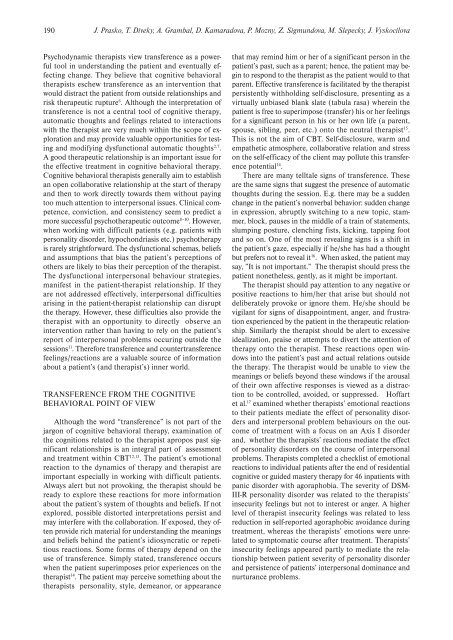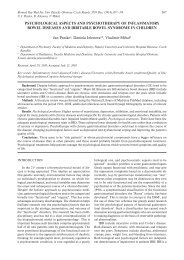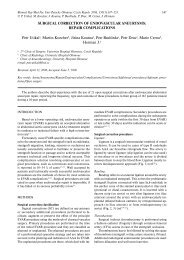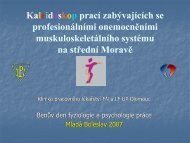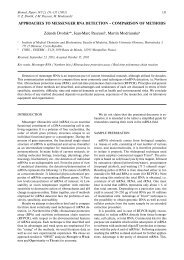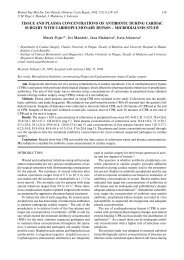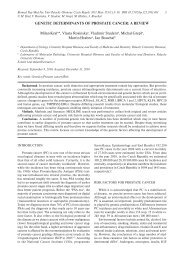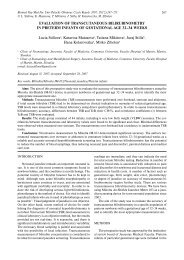Transference and countertransference in cognitive behavioral therapy
Transference and countertransference in cognitive behavioral therapy
Transference and countertransference in cognitive behavioral therapy
You also want an ePaper? Increase the reach of your titles
YUMPU automatically turns print PDFs into web optimized ePapers that Google loves.
190 J. Prasko, T. Diveky, A. Grambal, D. Kamaradova, P. Mozny, Z. Sigmundova, M. Slepecky, J. VyskocilovaPsychodynamic therapists view transference as a powerfultool <strong>in</strong> underst<strong>and</strong><strong>in</strong>g the patient <strong>and</strong> eventually effect<strong>in</strong>gchange. They believe that <strong>cognitive</strong> <strong>behavioral</strong>therapists eschew transference as an <strong>in</strong>tervention thatwould distract the patient from outside relationships <strong>and</strong>risk therapeutic rupture 6 . Although the <strong>in</strong>terpretation oftransference is not a central tool of <strong>cognitive</strong> <strong>therapy</strong>,automatic thoughts <strong>and</strong> feel<strong>in</strong>gs related to <strong>in</strong>teractionswith the therapist are very much with<strong>in</strong> the scope of exploration<strong>and</strong> may provide valuable opportunities for test<strong>in</strong>g<strong>and</strong> modify<strong>in</strong>g dysfunctional automatic thoughts 2,7 .A good therapeutic relationship is an important issue forthe effective treatment <strong>in</strong> <strong>cognitive</strong> <strong>behavioral</strong> <strong>therapy</strong>.Cognitive <strong>behavioral</strong> therapists generally aim to establishan open collaborative relationship at the start of <strong>therapy</strong><strong>and</strong> then to work directly towards them without pay<strong>in</strong>gtoo much attention to <strong>in</strong>terpersonal issues. Cl<strong>in</strong>ical competence,conviction, <strong>and</strong> consistency seem to predict amore successful psychotherapeutic outcome 8–10 . However,when work<strong>in</strong>g with difficult patients (e.g. patients withpersonality disorder, hypochondriasis etc.) psycho<strong>therapy</strong>is rarely strightforward. The dysfunctional schemas, beliefs<strong>and</strong> assumptions that bias the patient’s perceptions ofothers are likely to bias their perception of the therapist.The dysfunctional <strong>in</strong>terpersonal behaviour strategies,manifest <strong>in</strong> the patient-therapist relationship. If theyare not addressed effectively, <strong>in</strong>terpersonal difficultiesaris<strong>in</strong>g <strong>in</strong> the patient-therapist relationship can disruptthe <strong>therapy</strong>. However, these difficulties also provide thetherapist with an opportunity to directly observe an<strong>in</strong>tervention rather than hav<strong>in</strong>g to rely on the patient’sreport of <strong>in</strong>terpersonal problems occur<strong>in</strong>g outside thesessions 11 . Therefore transference <strong>and</strong> <strong>countertransference</strong>feel<strong>in</strong>gs/reactions are a valuable source of <strong>in</strong>formationabout a patient’s (<strong>and</strong> therapist’s) <strong>in</strong>ner world.TRANSFERENCE FROM THE COGNITIVEBEHAVIORAL POINT OF VIEWAlthough the word “transference” is not part of thejargon of <strong>cognitive</strong> <strong>behavioral</strong> <strong>therapy</strong>, exam<strong>in</strong>ation ofthe cognitions related to the therapist apropos past significantrelationships is an <strong>in</strong>tegral part of assessment<strong>and</strong> treatment with<strong>in</strong> CBT 12,13 . The patient’s emotionalreaction to the dynamics of <strong>therapy</strong> <strong>and</strong> therapist areimportant especially <strong>in</strong> work<strong>in</strong>g with difficult patients.Always alert but not provok<strong>in</strong>g, the therapist should beready to explore these reactions for more <strong>in</strong>formationabout the patient’s system of thoughts <strong>and</strong> beliefs. If notexplored, possible distorted <strong>in</strong>terpretations persist <strong>and</strong>may <strong>in</strong>terfere with the collaboration. If exposed, they oftenprovide rich material for underst<strong>and</strong><strong>in</strong>g the mean<strong>in</strong>gs<strong>and</strong> beliefs beh<strong>in</strong>d the patient’s idiosyncratic or repetitiousreactions. Some forms of <strong>therapy</strong> depend on theuse of transference. Simply stated, transference occurswhen the patient superimposes prior experiences on thetherapist 14 . The patient may perceive someth<strong>in</strong>g about thetherapists personality, style, demeanor, or appearancethat may rem<strong>in</strong>d him or her of a significant person <strong>in</strong> thepatient’s past, such as a parent; hence, the patient may beg<strong>in</strong>to respond to the therapist as the patient would to thatparent. Effective transference is facilitated by the therapistpersistently withhold<strong>in</strong>g self-disclosure, present<strong>in</strong>g as avirtually unbiased blank slate (tabula rasa) where<strong>in</strong> thepatient is free to superimpose (transfer) his or her feel<strong>in</strong>gsfor a significant person <strong>in</strong> his or her own life (a parent,spouse, sibl<strong>in</strong>g, peer, etc.) onto the neutral therapist 15 .This is not the aim of CBT. Self-disclosure, warm <strong>and</strong>empathetic atmosphere, collaborative relation <strong>and</strong> stresson the self-efficacy of the client may pollute this transferencepotential 14 .There are many telltale signs of transference. Theseare the same signs that suggest the presence of automaticthoughts dur<strong>in</strong>g the session. E.g. there may be a suddenchange <strong>in</strong> the patient’s nonverbal behavior: sudden change<strong>in</strong> expression, abruptly switch<strong>in</strong>g to a new topic, stammer,block, pauses <strong>in</strong> the middle of a tra<strong>in</strong> of statements,slump<strong>in</strong>g posture, clench<strong>in</strong>g fists, kick<strong>in</strong>g, tapp<strong>in</strong>g foot<strong>and</strong> so on. One of the most reveal<strong>in</strong>g signs is a shift <strong>in</strong>the patient’s gaze, especially if he/she has had a thoughtbut prefers not to reveal it 16 . When asked, the patient maysay, ”It is not important.” The therapist should press thepatient nonetheless, gently, as it might be important.The therapist should pay attention to any negative orpositive reactions to him/her that arise but should notdeliberately provoke or ignore them. He/she should bevigilant for signs of disappo<strong>in</strong>tment, anger, <strong>and</strong> frustrationexperienced by the patient <strong>in</strong> the therapeutic relationship.Similarly the therapist should be alert to excessiveidealization, praise or attempts to divert the attention of<strong>therapy</strong> onto the therapist. These reactions open w<strong>in</strong>dows<strong>in</strong>to the patient’s past <strong>and</strong> actual relations outsidethe <strong>therapy</strong>. The therapist would be unable to view themean<strong>in</strong>gs or beliefs beyond these w<strong>in</strong>dows if the arousalof their own affective responses is viewed as a distractionto be controlled, avoided, or suppressed. Hoffartet al. 17 exam<strong>in</strong>ed whether therapists’ emotional reactionsto their patients mediate the effect of personality disorders<strong>and</strong> <strong>in</strong>terpersonal problem behaviours on the outcomeof treatment with a focus on an Axis I disorder<strong>and</strong>, whether the therapists’ reactions mediate the effectof personality disorders on the course of <strong>in</strong>terpersonalproblems. Therapists completed a checklist of emotionalreactions to <strong>in</strong>dividual patients after the end of residential<strong>cognitive</strong> or guided mastery <strong>therapy</strong> for 46 <strong>in</strong>patients withpanic disorder with agoraphobia. The severity of DSM-III-R personality disorder was related to the therapists’<strong>in</strong>security feel<strong>in</strong>gs but not to <strong>in</strong>terest or anger. A higherlevel of therapist <strong>in</strong>security feel<strong>in</strong>gs was related to lessreduction <strong>in</strong> self-reported agoraphobic avoidance dur<strong>in</strong>gtreatment, whereas the therapists’ emotions were unrelatedto symptomatic course after treatment. Therapists’<strong>in</strong>security feel<strong>in</strong>gs appeared partly to mediate the relationshipbetween patient severity of personality disorder<strong>and</strong> persistence of patients’ <strong>in</strong>terpersonal dom<strong>in</strong>ance <strong>and</strong>nurturance problems.


